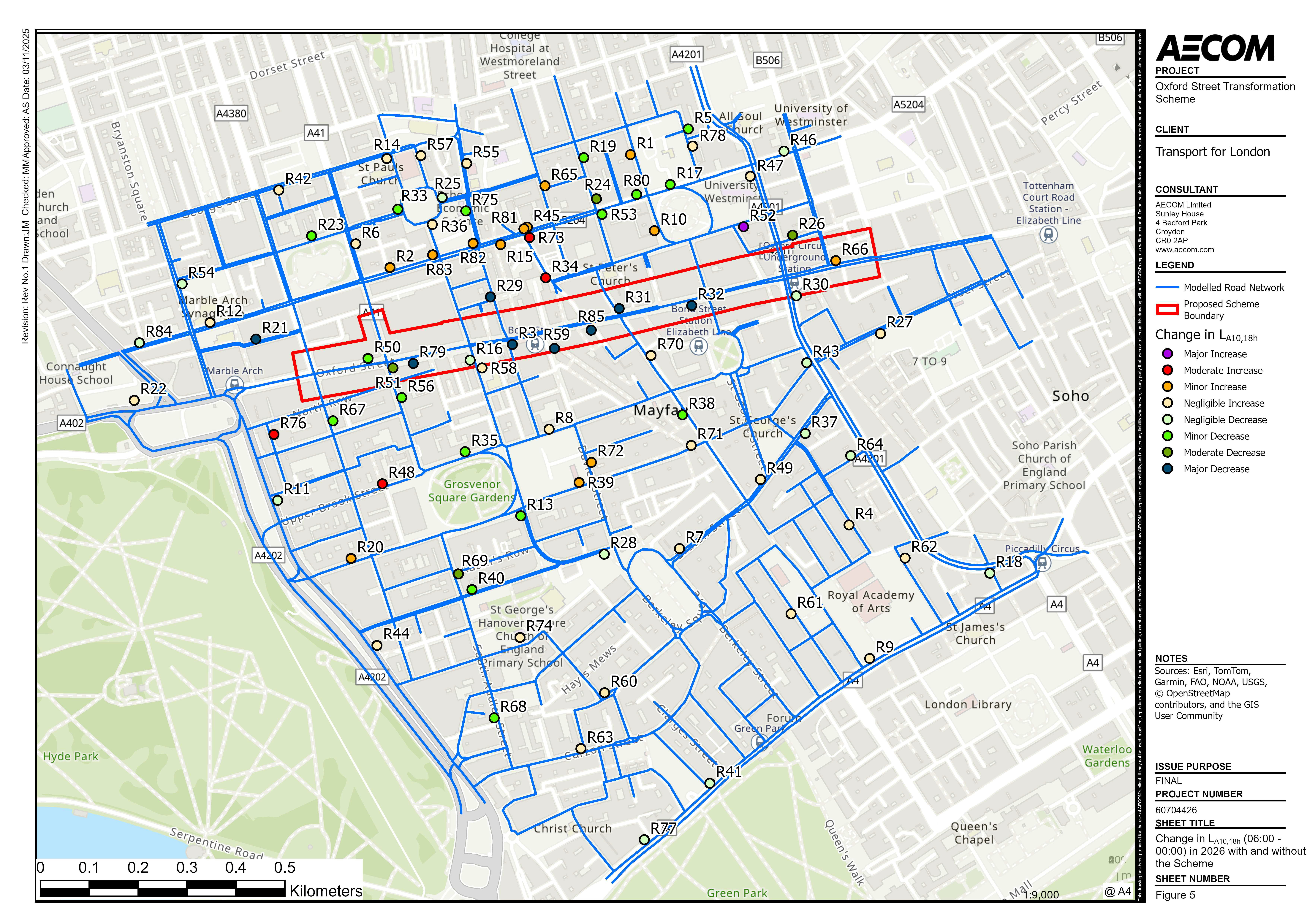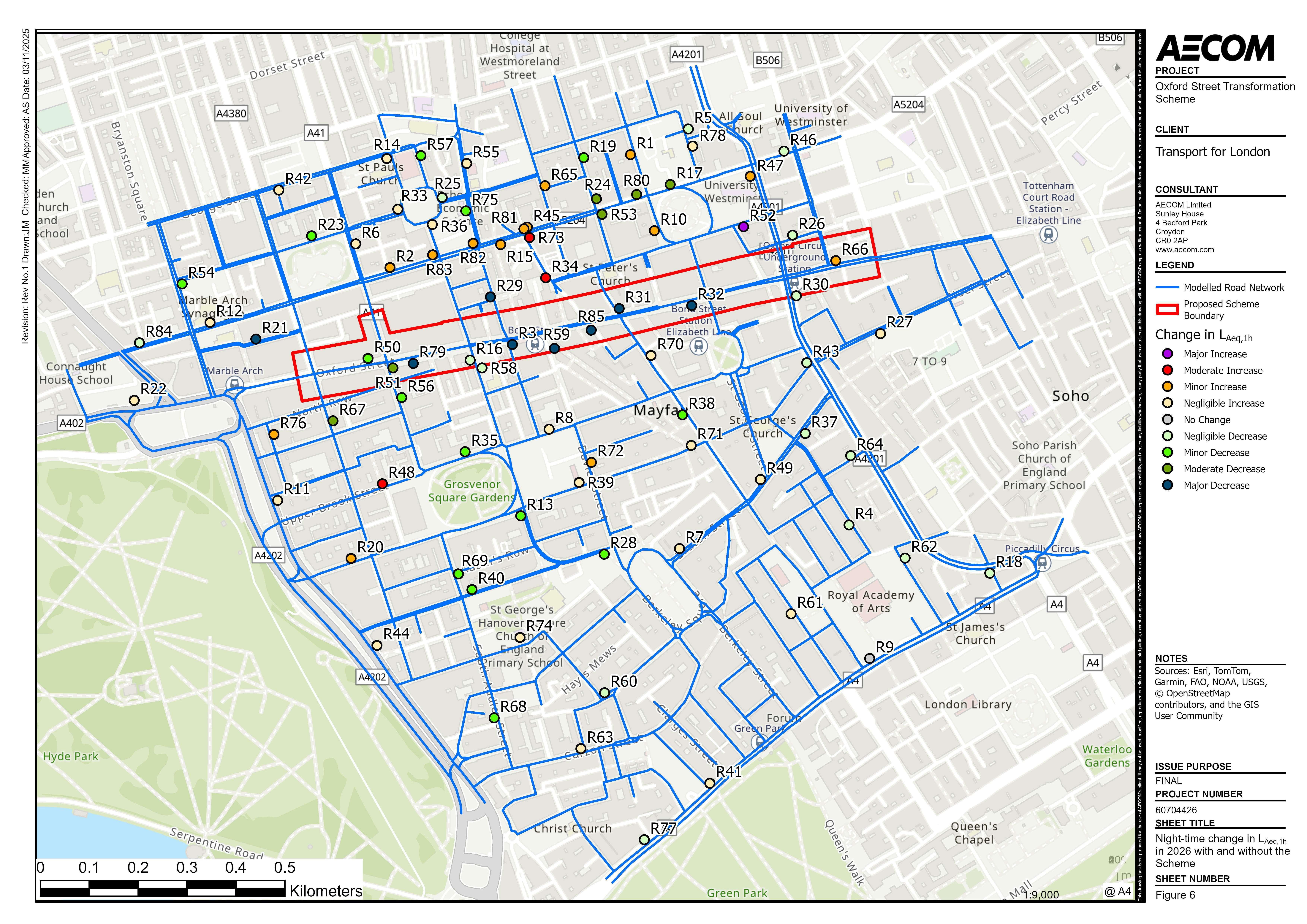Noise
We have undertaken a Noise assessment to understand what the likely impacts would be of pedestrianising Oxford Street West in accordance with our proposals. This work is being supported by external independent consultants who have undertaken modelling work for us. The assessment covers road traffic noise at 80 selected sensitive locations such as residential properties, schools, hospitals and local community buildings and spaces within the study area.
The work has used outputs from the traffic modelling to ensure consistency and accuracy of our model predictions. We have also been undertaking monitoring of existing Noise levels in and around Oxford Street to underpin the assessments.
How have noise impacts been determined?
Our noise modelling is based on traffic speed and flow data from the traffic reassignment model which is used to understand traffic flow changes on London’s road Network. The outputs from the traffic model are fed into the respective noise models which allows to understand what the forecasted changes in, and noise associated with the proposed scheme are likely to be.
The assessments consider the following scenarios:
- Baseline Situation: the current levels of noise for Oxford Street and Central London
- Future Situation without Oxford Street West Proposals: the current baseline situation but with other committed developments and other road improvements planned for implementation up to 2026
-
Future Situation with Oxford Street West Proposals: the Oxford Street proposals and other committed developments and road improvements planned for implementation up to 2026
What are the potential impacts, what does this mean for me?
Baseline situation
The existing sound environment in and around Oxford Street is heavily dominated by road traffic noise. Areas with the highest noise levels include Oxford Street, Regent Street, Park Lane, Marble Arch, Piccadilly, Edgeware Road, Gloucester Place, Baker Street and Wigmore Street. Designated areas of high traffic noise levels are called Noise Important Areas (NIA), and there are five in the vicinity of the Proposed Scheme. These areas cover Oxford Street, Regent Street, Piccadilly, Park Lane, Edgeware Road, Bayswater Road and Gloucester Place.
Other noise sources in the vicinity of the Proposed Scheme include pedestrians and noise from many commercial premises, including many restaurants. On Oxford Street and Regent Street in particular noise from deliveries to commercial premises also contribute to the overall sound environment.
Future Scenario without
In the future scenario without the Proposed Scheme in place high noise levels are predicted at 36 of the 80 representative receptors in the daytime and 50 at night-time. The future road traffic noise levels without the scheme are generally between 60dB and 75dB. These levels are typical for buildings close to major roads or in busy city centres such as London. These high noise levels are typically present in the same areas highlighted in the baseline section above.
The majority of the remaining representative noise sensitive receptors are still subject to a degree of traffic noise, indicating that there are relatively few quiet areas in the vicinity of the Proposed Scheme.
Future Scenario with
With the Proposed Scheme in place traffic noise still dominates the study area but high traffic noise levels are no longer predicted in many parts of central London, including: Oxford Street, Bryanston Street, Wimpole Street, Great Castle Street, Vere Street, James Street, North Audley Street, South Audley Street and South Molton Street. The largest reductions in traffic noise are expected on Oxford Street, Bryanston Street and James Street which see reduction in noise between 11.1dB and 24.1dB.
However, because of Oxford Street closing to traffic some roads experience an increase in road traffic noise because of re-routed traffic. Some areas are expected to become subject to higher levels of traffic noise, which include: Margaret Street, Upper Brook Street, Marylebone Lane, Dunraven Street and Stratford Place which see an increase in noise between 3.2dB and 7.8dB.
The map below shows the changes in daytime noise and figure 2 shows the changes in nighttime noise between the without and with scheme scenarios.
Summary
Among the 80 modelled sensitive receptors there are 27 which experience a reduction in road noise and 15 which experience an increase. Table 1 below provides a breakout of the level of change.
Table 1 number of changes in noise levels.
Level of change |
Number of locations |
Large decrease |
7 |
Medium decrease |
4 |
Small decrease |
16 |
Imperceptible/ No change |
38 |
Small increase |
10 |
Medium increase |
4 |
Large increase |
1 |
The existing sound environment along Oxford Street and the surrounding area is heavily dominated by road traffic noise. The study area is also a very heavily touristed area there is general noise from pedestrians on the busy footpaths and noise from a large number of commercial premises. This is especially the case along Oxford Street and Regent Street. The large number of commercial premises within these areas also see deliveries therefore loading and unloading activities from HGV vehicles as well. Other areas include residential properties, schools, hospitals and local community buildings and spaces within the study area which form part of the overall urban environment within the study area.
Overall, it is predicted that traffic noise levels are likely to change as a result of Oxford Street west pedestrianisation which could see both reductions and increase in noise across the study area due to rerouted traffic.







Thank you for your contribution!
Help us reach out to more people in the community
Share this with family and friends